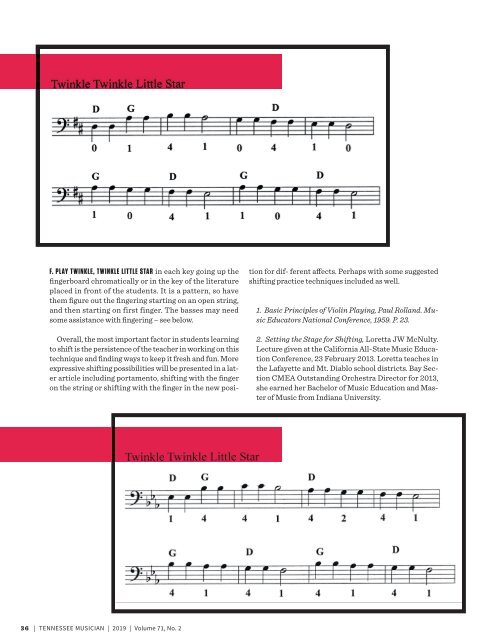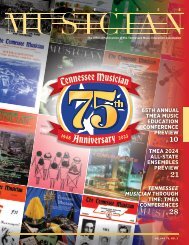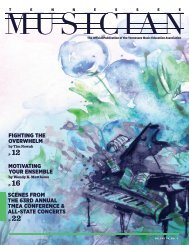TN Musician Vol. 71 No. 2
You also want an ePaper? Increase the reach of your titles
YUMPU automatically turns print PDFs into web optimized ePapers that Google loves.
F. PLAY TWINKLE, TWINKLE LITTLE STAR in each key going up the<br />
fingerboard chromatically or in the key of the literature<br />
placed in front of the students. It is a pattern, so have<br />
them figure out the fingering starting on an open string,<br />
and then starting on first finger. The basses may need<br />
some assistance with fingering – see below.<br />
Overall, the most important factor in students learning<br />
to shift is the persistence of the teacher in working on this<br />
technique and finding ways to keep it fresh and fun. More<br />
expressive shifting possibilities will be presented in a later<br />
article including portamento, shifting with the finger<br />
on the string or shifting with the finger in the new position<br />
for dif- ferent affects. Perhaps with some suggested<br />
shifting practice techniques included as well.<br />
1. Basic Principles of Violin Playing, Paul Rolland. Music<br />
Educators National Conference, 1959. P. 23.<br />
2. Setting the Stage for Shifting, Loretta JW McNulty.<br />
Lecture given at the California All-State Music Education<br />
Conference, 23 February 2013. Loretta teaches in<br />
the Lafayette and Mt. Diablo school districts. Bay Section<br />
CMEA Outstanding Orchestra Director for 2013,<br />
she earned her Bachelor of Music Education and Master<br />
of Music from Indiana University.<br />
36 | TENNESSEE MUSICIAN | 2019 | <strong>Vol</strong>ume <strong>71</strong>, <strong>No</strong>. 2

















